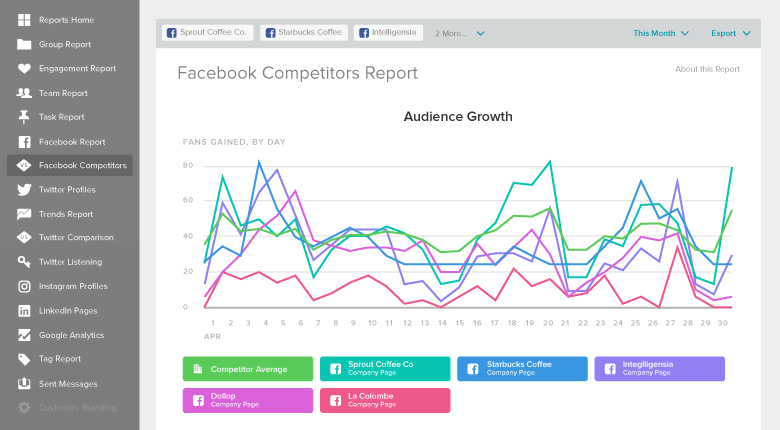In the digital age, understanding your audience has become crucial for successful marketing strategies. Social listening marketing is a powerful tool that allows businesses to gain valuable insights by monitoring and analyzing conversations happening on social media platforms. By paying attention to what people are saying about your brand, industry, or competitors, you can adapt your marketing efforts and build stronger relationships with your target audience. This article will delve into the concept of social listening marketing, its importance, its techniques, and its application in various aspects of the business.
What is Social Listening Marketing?

Social listening marketing is the process of monitoring and analyzing online conversations related to your brand, products, industry, or competitors. It involves tracking mentions, discussions, and sentiment analysis across social media platforms, blogs, forums, and review sites. Social listening goes beyond social media monitoring, as it focuses on understanding the context and sentiment behind the conversations to extract valuable insights.
The Importance of Social Listening Marketing
Understanding the voice of your audience is essential for effective marketing. Social listening marketing offers several benefits, including:
- Customer Insights: By listening to what your audience is saying, you can understand their needs, preferences, and pain points, enabling you to tailor your marketing messages and offerings accordingly.
- Reputation Management: Social listening allows you to proactively manage your brand’s reputation by addressing customer concerns and resolving issues promptly.
- Competitor Analysis: By monitoring your competitors’ conversations, you can gain insights into their strategies, strengths, weaknesses, and customer perception, helping you stay ahead in the market.
- Product and Service Development: Social listening provides valuable feedback on your existing products or services and helps identify opportunities for innovation and improvement.
- Customer Engagement: Engaging with your audience on social media platforms builds trust, loyalty, and brand advocacy, resulting in increased customer engagement and satisfaction.
How Does Social Media Listening Work?
Social listening involves the following steps:
- Defining Goals: Determine what you want to achieve through social listening, such as understanding customer sentiment, tracking brand mentions, or identifying industry trends.
- Selecting Relevant Channels: Identify the social media platforms, forums, blogs, and review sites where your target audience is most active.
- Monitoring and Gathering Data: Utilize social listening tools to track and collect relevant data, including mentions, hashtags, keywords, and sentiment analysis.
- Analyzing and Extracting Insights: Analyze the gathered data to extract actionable insights about your audience, industry trends, and competitor activities.
- Taking Action: Apply the obtained insights to refine your marketing strategies, improve products or services, and engage with your audience effectively.
Tools and Techniques for Effective Social Listening

To conduct effective social listening, you can leverage various tools and techniques, such as:
- Social Media Monitoring Tools: Platforms like AIM Insights, Sprout Social, and Brandwatch provide features for tracking mentions, keywords, and sentiment analysis.
- Keyword Tracking: Monitor relevant keywords, hashtags, and phrases to identify conversations related to your brand or industry.
- Sentiment Analysis: Utilize sentiment analysis tools to gauge the emotional tone behind conversations and understand how people perceive your brand.
- Influencer Identification: Identify key influencers in your industry and engage with them to amplify your brand message.
- Competitor Analysis Tools: Tools like SEMrush and BuzzSumo help track and analyze your competitors’ online activities and their impact on the audience.
Leveraging Social Listening for Brand Reputation Management
Social listening plays a vital role in brand reputation management. By monitoring conversations and promptly addressing customer concerns, you can build a positive brand image and foster customer loyalty. Here are some key strategies for effective brand reputation management through social listening:
- Prompt Response: Monitor mentions and direct messages to address customer queries, complaints, or feedback promptly.
- Identify Brand Advocates: Identify and engage with customers who speak positively about your brand, leveraging their influence to amplify your brand message.
- Addressing Negative Feedback: Respond professionally and empathetically to negative feedback, offering solutions or assistance to resolve issues.
- Crisis Management: Detect and manage potential crises by monitoring conversations and taking swift action to mitigate negative sentiment.
Harnessing Social Listening for Product and Service Development
Social listening provides valuable insights for product and service development. By analyzing customer feedback and preferences, businesses can enhance existing offerings and identify new opportunities. Here’s how social listening can contribute to product and service development:
- Identify Pain Points: Analyze customer discussions and reviews to understand the pain points or dissatisfaction with your products or services.
- Feature Enhancement: Gain insights on desired features or improvements that customers are discussing, enabling you to prioritize product enhancements.
- Discovering New Opportunities: Uncover unmet needs or emerging trends in your industry through social listening, allowing you to innovate and stay ahead of the competition.
Social Media Listening for Competitor Analysis

Monitoring your competitors’ online activities and customer perception can provide a competitive edge. Social listening helps you gain insights into their strategies, strengths, weaknesses, and customer sentiment. Here’s how social listening aids competitor analysis:
- Identify Competitor Strategies: Analyze competitor conversations to understand their marketing strategies, content themes, and promotional activities.
- Benchmarking Performance: Compare your brand’s sentiment, engagement, and reach with that of your competitors to gauge your market position.
- Identify Gaps and Opportunities: Uncover areas where your competitors are falling short or gaps in the market that you can exploit to differentiate your brand.
Enhancing Customer Engagement through Social Listening
Social listening allows businesses to engage with their audience effectively, fostering strong relationships and brand loyalty. Here are some strategies to enhance customer engagement through social listening:
- Join Conversations: Actively participate in discussions relevant to your industry, providing valuable insights, answering queries, and showcasing your expertise.
- Personalized Interactions: Tailor your responses to customer queries or comments, addressing them by name and offering personalized assistance or recommendations.
- Social Media Contests and Campaigns: Leverage social listening to identify trending topics or discussions and organize contests or campaigns that resonate with your audience.
- User-Generated Content: Acknowledge and share user-generated content to foster a sense of community and encourage further engagement.
- Social Listening as a Feedback Channel: Use social listening to gather customer feedback, suggestions, and ideas, making customers feel valued and heard.
Integrating Social Media Listening into Your Marketing Strategy
To effectively integrate social listening into your marketing strategy, follow these steps:
- Set Clear Objectives: Define specific goals and objectives for social listening aligned with your overall marketing strategy.
- Identify Key Metrics: Determine the key performance indicators (KPIs) you will track to measure the success of your social listening efforts, such as sentiment analysis, engagement rates, or brand mentions.
- Select the Right Tools: Choose social listening tools that align with your needs, providing comprehensive data analysis and reporting capabilities.
- Allocate Resources: Dedicate resources, including time and personnel, to actively monitor and analyze social conversations.
- Integrate Insights into Decision-Making: Regularly review and incorporate social listening insights into your marketing campaigns, content creation, and product/service development processes.
Measuring the Success of Social Listening Campaigns
Measuring the success of your social listening campaigns is essential to understand their impact and optimize future strategies. Here are some key metrics to track:
- Sentiment Analysis: Monitor changes in sentiment towards your brand over time, identifying shifts and taking corrective actions if necessary.
- Engagement Rates: Track the level of audience engagement, such as likes, comments, shares, and mentions.
- Reach and Impressions: Measure the reach and impressions of your social media content to assess its visibility and impact.
- Brand Mentions: Keep track of the frequency and context of brand mentions, identifying positive or negative trends.
- Share of Voice: Compare your brand’s online presence and conversations to that of your competitors, evaluating your market share.
The Future of Social Listening in Marketing

As technology and consumer behavior evolve, social listening will continue to play a crucial role in marketing strategies. Here are some emerging trends and predictions for the future of social listening marketing:
- AI-Powered Social Listening: Advanced artificial intelligence (AI) algorithms will enhance social listening capabilities, enabling deeper analysis.
- Multilingual Social Listening: Social listening tools will become more proficient in analyzing conversations in multiple languages, facilitating global marketing strategies.
- Real-Time Response: With the increasing speed of communication, real-time social listening and response will become paramount, allowing businesses to address customer needs promptly.
- Integration with Customer Relationship Management (CRM): Social listening will be integrated with CRM systems, providing a comprehensive view of customer interactions across multiple channels.
- Predictive Analytics: Social listening will leverage predictive analytics to anticipate trends, customer behavior, and emerging market opportunities.
Case Studies: Record-Breaking Social Listening Success Stories
Case Study 1: Netflix – Leveraging Social Listening for Content Strategy
Netflix is a prime example of how social listening can influence content strategy. By analyzing online conversations, trending hashtags, and viewer sentiments, Netflix identifies what genres, themes, and characters resonate with audiences. For instance, after noticing increased social media discussions around nostalgia-driven content, Netflix launched “Stranger Things,” which became a massive success.
Influencer Quote:
“Netflix is a master of social listening. They don’t just follow trends; they anticipate them.” – Gary Vaynerchuk (@garyvee), Digital Marketing Expert
Case Study 2: Wendy’s – Social Listening for Engagement & Brand Personality
Wendy’s Twitter strategy is legendary, thanks to its use of social listening to craft witty responses and engage with audiences in real-time. The brand listens to what users are saying, identifies viral moments, and jumps into conversations in a humorous and relatable way. One of its most famous interactions was roasting McDonald’s for their frozen beef, which went viral and boosted Wendy’s brand visibility.
Influencer Quote:
“Wendy’s has set the gold standard for real-time engagement. Brands, take notes.” – Neil Patel (@neilpatel), Digital Marketing Expert
Case Study 3: Nike – Social Listening for Social Justice Initiatives
Nike has successfully used social listening to understand societal trends and audience sentiments. When the conversation around social justice and equality gained momentum, Nike launched the “Believe in Something” campaign featuring Colin Kaepernick. Despite initial controversy, the campaign resonated with Nike’s core audience, leading to a significant sales increase.
Influencer Tweet:
“Nike knows its audience. Social listening isn’t just about selling; it’s about standing for something.” – Simon Sinek (@simonsinek), Leadership & Marketing Author
Case Study 4: Samsung – Using Social Listening for Product Innovation
Samsung uses social listening to analyze customer feedback and competitor products. When users frequently mentioned battery life concerns about smartphones, Samsung developed the Galaxy M series with long-lasting battery features. This strategic move was based on insights gathered from millions of online conversations.
Influencer Tweet:
“Samsung’s approach to listening and adapting is why they remain a smartphone leader.” – Marques Brownlee (@MKBHD), Tech Reviewer
Case Study 5: Airbnb – Social Listening to Enhance Customer Experience
Airbnb relies on social listening to identify travelers’ pain points and enhance customer experience. By analyzing reviews and social media conversations, they improved their platform’s safety features and introduced more flexible cancellation policies during the COVID-19 pandemic.
Influencer Quote:
“Airbnb doesn’t just rent out homes; they listen and evolve with their customers’ needs.” – Ann Handley (@MarketingProfs), Content Marketing Expert
Conclusion
Social listening marketing offers invaluable insights into your audience’s voice, helping you understand their needs, preferences, and perceptions. By actively monitoring and analyzing social conversations, you can adapt your marketing strategies, improve brand reputation, and enhance customer engagement. Remember to utilize appropriate tools, establish clear objectives, and integrate social listening insights into your decision-making processes to maximize the benefits. Embrace social listening as a powerful tool to gain a competitive edge and build meaningful connections with your target audience.
To experience the power of social listening firsthand and unlock its potential for your business, request a demo from AIM Technologies today. Discover how our cutting-edge social listening platform can revolutionize your marketing efforts, enhance customer understanding, and drive business growth. Don’t miss out on this opportunity to stay ahead of the competition and truly connect with your audience.
FAQs
Q1. How often should I engage in social listening?
- It is recommended to engage in social listening regularly, ideally daily. However, the frequency can vary depending on your industry, audience size, and available resources.
Q2. Can social listening help with crisis management?
- Yes, social listening is crucial for effective crisis management. By monitoring conversations in real time, you can identify potential crises, address negative sentiment promptly, and take appropriate actions to mitigate the impact.
Q3. How can social listening benefit small businesses?
- Social listening is particularly beneficial for small businesses as it helps them understand their target audience, compete with larger competitors, and build strong customer relationships based on personalized interactions and tailored marketing strategies.
Q4. Which social media platforms should I focus on for social listening?
- The choice of social media platforms for social listening depends on your target audience and industry. Identify the platforms where your audience is most active and engage in conversations relevant to your brand.
Q5. Can social listening be automated?
- While some aspects of social listening can be automated, such as data gathering and sentiment analysis, human interpretation and intervention are crucial for accurate insights and effective decision-making.




